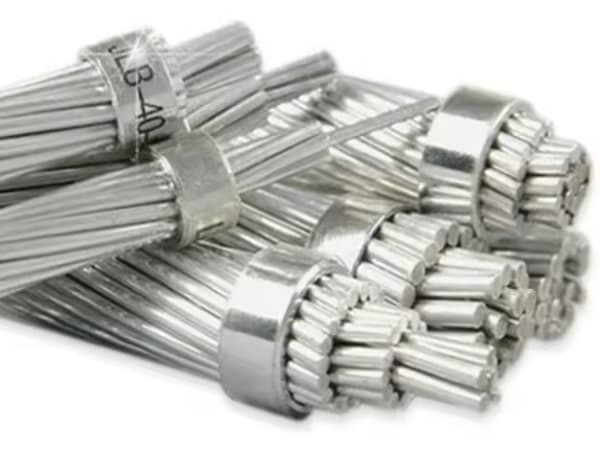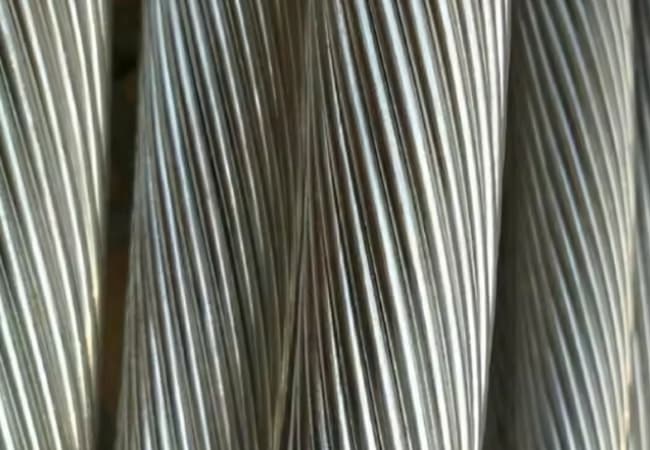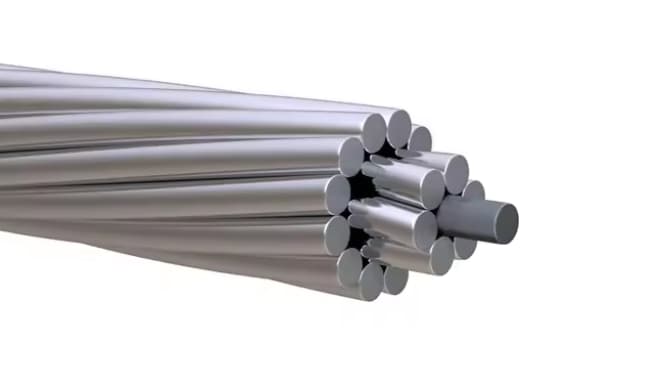
The main differences between the ACSR (Aluminium Conductor Steel Reinforced) Dog Conductor and Panther Conductor are reflected in their specifications, construction, Application areas and possibly other features. Since the detailed specifications for a direct comparison of two specific models may vary from one manufacturer to another and from one standard to another, Possible differences are outlined below based on general descriptions:
1.ACSR Dog Conductor and Panther Condutor Specifications and Construction
Conductor ACSR Dog: Typically refers to an ACSR conductor with a specific combination of aluminum wires and steel core construction, For example, an ACSR Dog driver 100 mm² can contain six aluminum wires of 4,72 mm and seven steel cores 1,57 mm. This construction combines the conductivity of aluminum with the mechanical resistance of steel.
Conductor ACSR Panther: Although exact specifications may vary from product to product, in general, Panther conductor may have larger cross-sectional area, For example 200 mm², and can contain more aluminum wires and steel cores to support higher current carrying capacity and mechanical strength. For example, in reference to the ACSR Panther driver of 200 mm² 30/7mm, This may mean that the conductor is made up of some combination of 30 3mm (possibly a mix of aluminum and steel cores).
2. ACSR Dog Conductor and Panther Condutor Scopes of Application
ACSR Dog Conductor: Due to its modest size and profitability, Dog Conductor is widely used in low and medium voltage overhead transmission lines as a primary and secondary bare conductor for distribution lines.
ACSR Panther Conductor: Due to its larger cross-sectional area and potentially higher current carrying capacity, The Panther Conductor is best suited for high voltage or ultra high voltage transmission lines, as well as for applications that require greater mechanical resistance.
3. ACSR Dog Condutor and Panther Condutor Other Features
Both follow relevant international standards, as IEC, ASTM, FROM, etc., to ensure quality and performance.
Its electrical and mechanical properties, like resistance, breaking load, the temperature range, etc., may vary depending on specific specifications and manufacturers.
Customization options may also vary from product to product, including insulation materials, packaging methods, marking and certification.

4. ACSR Dog Driver and Panther Driver Precautions
Since the specific specifications and performance of ACSR conductors may vary depending on the manufacturer, the standard and application, it is necessary to carefully consult the relevant documentation and specification sheets when selecting and using them.
Selection of the proper type of ACSR conductor is essential to ensure the reliability and economy of the power transmission system., taking into account the weight of the driver, installation and maintenance costs and expected loading and environmental conditions.
5. ACSR Dog Conductor and Panther Condutor Specification Differences
Driver size: ACSR Dog driver and Panther driver may have significant differences in driver size. As stated above, dog conductor may have a smaller cross section for low and medium voltage transmission lines, while the panther type conductor can have a larger cross section for high or ultra high voltage transmission lines. The difference lies mainly in the number of aluminum and steel cores, their diameters and the total outer diameter of the conductor.
Driver construction: Although both are a type of ACSR (aluminum braided steel), driver-specific construction (For example, the arrangement of aluminum and steel cores, braiding angle, etc.) may vary from one model to another. These structural differences affect the electrical and mechanical properties of the conductor..
6. ACSR Dog Conductor and Panther Condutor Performance Characteristics
Electrical performance: Due to differences in cross-sectional area and number of aluminum wires, Panther conductor may have lower resistance and higher current carrying capacity, allowing for more efficient transmission of electrical energy. Nevertheless, Exact performance will depend on actual product specifications and data provided by the manufacturer.
Mechanical properties: Panther Conductor typically has higher tensile strength and better wind pressure resistance, the ice cap, etc. due to its larger cross-sectional area and potentially larger number of steel cores. This allows it to maintain stable transmission performance even in adverse weather conditions..
7. ACSR Dog Conductor And Panther Condutor Apps
Conductor ACSR Dog: Due to its moderate specifications and cost-effectiveness, Dog conductor is widely used in medium and low voltage overhead transmission lines, especially in urban distribution networks, renewal of rural electrical networks and energy transmission in industrial facilities.
ACSR Panther Conductor: Due to its high performance characteristics, Panther Conductor is best suited for high voltage or ultra-high voltage transmission lines, large scale power plants, power transmission between substations, as well as important power facilities that require high reliability and stability.

8. ACSR Dog Conductor and Panther Condutor Customization Options
Both can offer customization options to meet the needs of different customers and application scenarios.. These options may include the choice of insulation materials (For example, bare wire, PVC insulation, XLPE insulation, etc.), adjustments to packaging methods (For example, packing in wooden drum, metal coil packaging, etc.) and the need for special brands and certifications.
9. Electrical performance differences
Resistance and current carrying capacity: In general, The Panther conductor is capable of carrying higher currents with lower resistance due to its larger cross-sectional area. This means that at the same voltage, The Panther Driver can transmit more power with less energy loss. Nevertheless, The exact resistance value and current carrying capacity should be determined based on the actual product specifications..
Temperature range: Conductor temperature range is an important consideration for transmission lines operating in high or low temperature environments. Although both the ACSR Dog Driver and the Panther Driver are designed to have a certain temperature range, The Panther Conductor can have a wider temperature range to adapt to more severe weather conditions.
10. Differences in mechanical properties
Tensile strength: As mentioned above, Panther conductor typically has a higher tensile strength due to its larger cross-sectional area and potentially higher number of steel cores. This makes it more stable and reliable in extreme weather conditions., such as strong winds and ice sheets.
Arch buckling characteristics: Arc buckling is the amount of buckling that occurs in a conductor under its own weight.. Panther Conductor may have better arch buckling characteristics due to its construction and material properties, which helps reduce the amount of buckling that occurs when the driver crosses long distances or complex terrain and improves line stability and safety.
11.Customization and cost
Customization options: Whether it is the ACSR Dog Conductor or the Panther Conductor, Manufacturers typically offer some degree of customization to meet the needs of different customers and application scenarios.. This includes, among other things, insulation options, packaging adjustments and special marking and certification needs. However, due to the complexity and high performance features of the Panther driver, the cost of customization can be relatively high.
Profitability: Cost effectiveness is an important consideration when selecting a driver. Although the Panther driver may outperform the ACSR Dog driver in terms of performance, It is also relatively expensive. Therefore, a combination of performance needs must be considered, budget constraints and long-term operating costs when deciding which driver to use.
12.Practical application considerations
Nominal line voltage: ACSR Dog Conductor and Panther Conductor are suitable for transmission lines of different nominal voltages. When selecting a driver, It is necessary to determine the appropriate type and size of conductor based on the line voltage level.
Environmental conditions: Environmental conditions have a significant impact on the selection and use of drivers. For example, with strong winds, ice and other adverse weather conditions, it is necessary to choose a conductor with greater mechanical resistance and better arc deformation characteristics.
Maintenance and replacement: The cost of maintenance and replacement of the driver is also a factor to take into account.. Although both the ACSR Dog Conductor and the Panther Conductor have good durability and maintenance, The Panther Conductor may require more specialized maintenance and replacement techniques due to its high performance characteristics.
In summary, There are significant differences between the ACSR Dog Conductor and the Panther Conductor in terms of electrical performance, mechanical performance, customization and cost, and practical application considerations. When selecting a driver, These factors must be considered in the context of specific application requirements and environmental conditions., in order to select the most suitable type and size of conductor.
